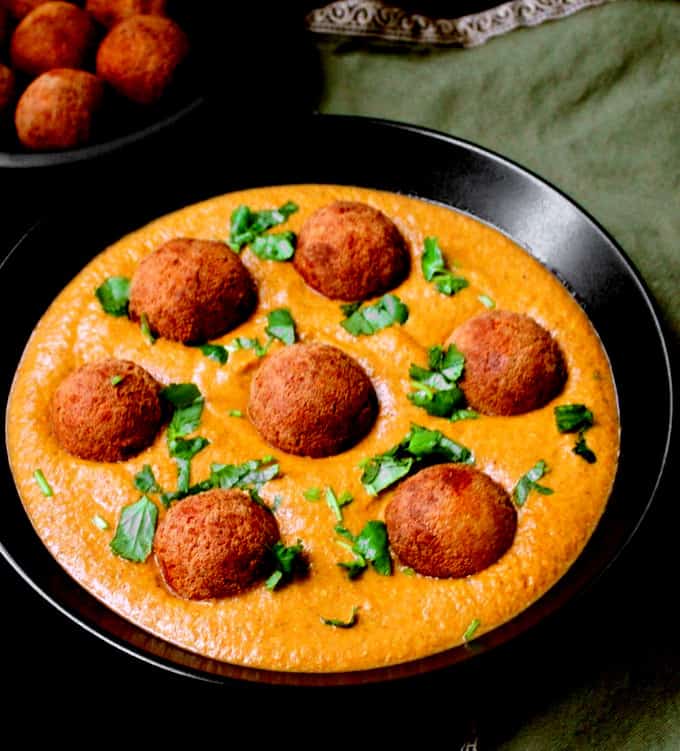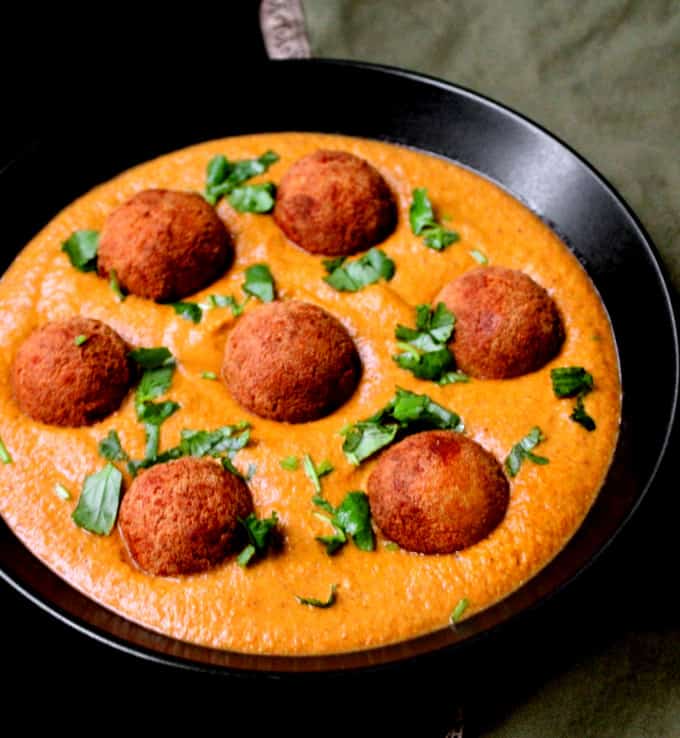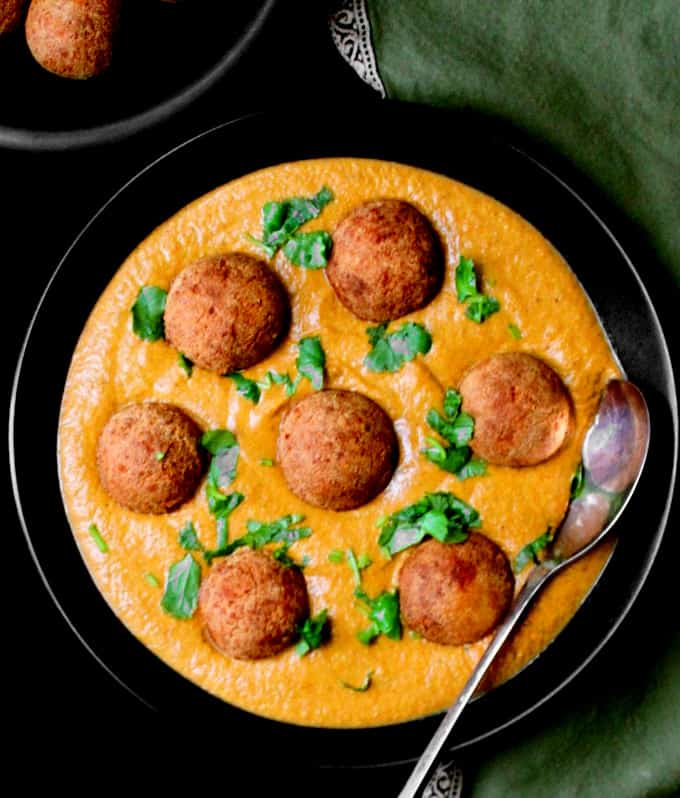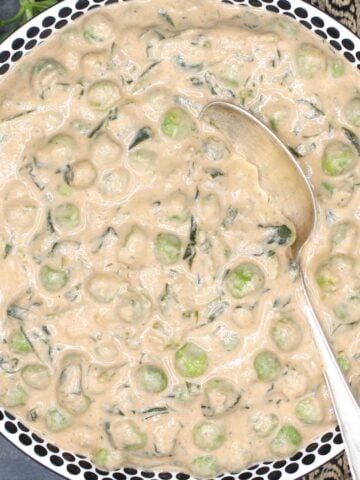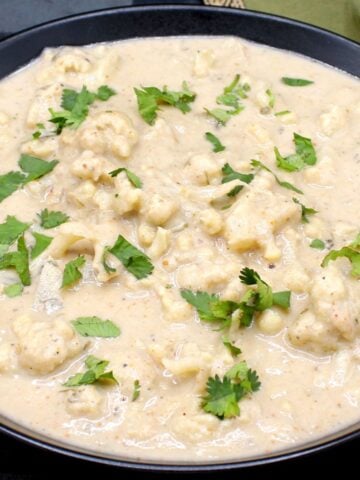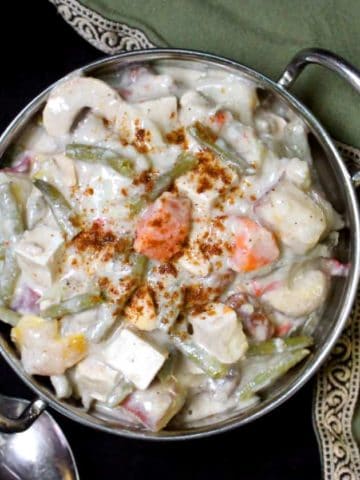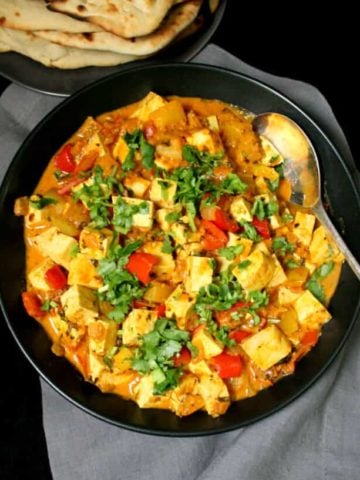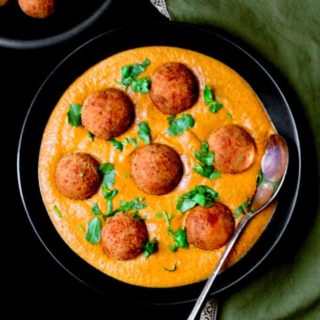You might also like these recipes for vegan Indian kofta, zucchini kofta curry and vegan kofta biryani. Malai kofta is a dazzling, vegetarian Indian dish: deep-fried, delicate balls of cheese, or kofta, float in a subtly but expertly spiced creamy and orange-gold sauce. Here, I will show you how to veganize this dish fit for royalty with no loss of flavor. In fact, even if you’re not vegan and you make this vegan malai kofta, you will become a convert!
What is malai kofta?
Koftas can be loosely described as meatballs, and they are often made with lamb or beef or chicken meat in India (check out these easy Indian style vegan koftas). However, vegetarian versions of kofta, like malai kofta, made with paneer, a fresh Indian cheese, and khoya, a reduction of milk, are just as – or perhaps more – popular. Koftas are not a concept native to India. Rather, like other popular Indian dishes like Vegetable Biryani, Samosa, Gulab Jamun and Navratan Korma, which have heavy central Asian and Persian influences, koftas originated in the kitchens of the Mughals, Muslim invaders from central Asia who went on to rule a large part of northern India for nearly two centuries. The Mughals were gone from India by the 19th century, but the food they popularized had already permeated and mingled with local north Indian cuisine, and it stayed put. Today, anyone can eat dishes like Malai Kofta at a north Indian restaurant anywhere in the world. Well, anyone except vegans.
Veganizing malai (cream) kofta
Given that the two key ingredients in a malai kofta are milk and paneer, making a vegan malai kofta can appear to be a difficult job. But more than a decade ago, when I first developed this recipe, I came up with two substitutions that worked really well: tofu and cashews. For the creamy, spicy, orange curry sauce I used cashew cream. No Indian I’ve served this vegan malai kofta to has ever guessed it’s vegan–it is quite perfect and full of flavor. Over the years so many of you have also made it, loved it, and come back to tell me about it.
A lush, restaurant-style malai kofta curry
Tasty. This vegan malai kofta curry is possibly going to be the most delicious Indian dish you’ve ever eaten, it’s that good. Creamy and luxurious. The mouthfeel of the koftas and the curry are just right, especially when paired with a naan or rice. Kid-friendly. The recipe has spices but it is not a spicy dish, thanks to all the cashew cream and tofu, and those pretty, deep-fried kofta balls are a kid magnet. Foolproof. This malai kofta curry involves a few steps but it is an easy enough recipe if you follow instructions.
Expert tips
If you’re familiar with Indian food, you likely know malai is the Hindi word for cream. But malai kofta balls do not actually have any malai or cream in them, only the sauce does. The ingredients for the koftas cannot be fluid, as cream is, because they have to hold together in a ball firm enough to fry. So Indian cooks usually use khoya instead of “malai” in the kofta balls. Khoya is made by boiling milk until all of the liquid has evaporated and all that remains are the thick milk solids. Paneer and a small amount of potato is added to the khoya to make the kofta balls. In my vegan version, I sub the paneer with tofu, the khoya with cashews, and thank heavens a potato is already vegan. 😉 For the cream sauce, instead of cream or malai, I use cashew cream. This is a recipe designed for royalty, so the flavors here have to be just right – not too spicy, not too overbearing, but delicate and voluptuous at the same time. So. Don’t go overboard with the quantity of spices. You want all of the ingredients in the kofta balls to be really, really creamy while remaining solid, so make sure everything is broken down really fine without any water added. Grate the tofu and then give it a turn in the food processor to make sure it’s as smooth as possible. You will need to process the raw cashews into a really fine powder, again without any water. The cashews help add richness to the kofta balls, the richness khoya would bring, so don’t skip them unless you are nut-free. You need very little potato in the kofta balls, because the potato is simply there to bind, not to add flavor. Too much potato will result in a dish of potato dumplings floating in the curry, and that’s not what you’re going for. Use one medium potato, boiled and peeled, for this dish. You also don’t need too much cornstarch or tapioca starch, depending on which one you’re using. You want these balls to be creamy, not doughy, and the starch, like the potato, is just a binder. After adding the spices and cornstarch, the kofta balls should hold together firmly and shouldn’t fall apart when you add them to the oil. Fry one ball first to make sure it holds, but if it doesn’t, add more cornstarch and proceed. Koftas are often stuffed with a little surprise inside, like nuts or raisins. I added raisins because I like the bit of sweetness here, but if you want to add nuts, use chopped pistachios and/or cashews and you can certainly add both nuts and raisins. If deep frying scares you, you could put your kofta balls in an air fryer or the oven, but you won’t get the same great crust or the flavor. My advise is to deep fry and eat in moderation. This is by no means an unhealthy recipe and it’s filling, so I doubt you’ll want to eat all of it at one go. The curry sauce that goes with the kofta is really simple to make, and it comes together quickly. You will need to process the sauce in the blender to make it really creamy, and then strain it for best results. I like the sauce thick here, but you can thin it out to your liking and for an even smoother texture. Use water to thin it out. The creaminess of the sauce comes from cashews and pumpkin seeds, which are both traditionally used in India. These also take away the need to add any cream to the sauce. Now here’s a big DON’T. Unless you’re nut-free and absolutely can’t use cashews or pumpkin seeds, don’t use coconut milk to add creaminess to the sauce–a mistake cooks unfamiliar with the nuances of Indian cuisine often make. Here’s the rule of thumb to remember: in south India, cooks use coconut milk to add creaminess to recipes. In north India, they use dairy products like butter and cream. Malai kofta is unequivocally north Indian and the strong flavor of coconut milk simply does not work here.
What to serve with vegan malai kofta
Vegan malai kofta goes beautifully with an Indian bread, like vegan naan, paratha or roti. You can also serve it with jeera rice and serve a vegan raita on the side. For dessert serve a classic Indian Mughlai dessert like vegan gulab jamun or vegan malpua. Check to get new recipe updates by email.
More restaurant style Indian recipes
Recipe card
